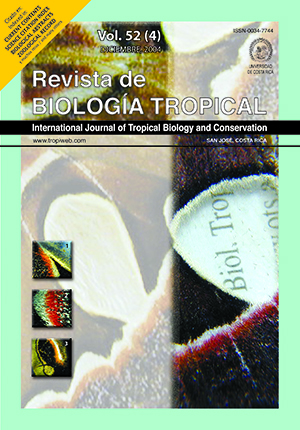Abstract
The occurrence of macrophyte in three high Andean lakes of Ecuador, Lago San Pablo, Laguna La Mica and Lago Cuicocha was recorded in 5-9 transects per lake. The first two lakes are eutrophic, the third is an extremely oligotrophic caldera lake. The dominant species in eutrophic lakes are Ceratophyllum demersum, Myriophyllum quitense, Potamogeton illinoensis, P. striatus and Elodea matthewsii. In the oligotrophic lake P. pectinatus, P. illinoensis, and the Characeae Chara rusbyana, Ch. globularis and Nitella acuminata occur. The maximum depth of the macrophyte’s presence can be used as an indicator of the trophic state, ranging from about 5 m in Mica to 35 m in Cuicocha. The bioindication value of the macrophyte species in these high Andean lakes is low, because few species occur and because some of them are not specific to environmental conditions.
References
Carpenter, S.R. & D.M. Lodge. 1986. Effects of submersed macrophytes on ecosystem processes. Aquat. Bot. 26: 341-370.
Chambers, P.A. & J. Kalff. 1985. Depth distribution and biomass of submersed aquatic macrophyte communities
in relation to Secchi depth. Can. J. Fish. Aquat. Sci. 42: 701-709.
Cimdins, P., I. Druvietis, R. Liepa, E. Parele, L. Urtane & A. Urtans. 1995. A Latvian catalogue of indicator species of freshwater. Proc. Latv. Acad. Sci., Section B 1/2: 122-133.
Cook, C.D.K. 1990. Aquatic Plant Book. SPB Academic, Amsterdam. 228 p.
Cook, C.D.K., B.J. Gut, E.M. Rix, J. Schneller & M. Seitz. 1974. Water Plants of the World. W. Junk, The Hague. 561 p.
Dennis, W.M. 1984. Aquatic Macrophyton Sampling: An overview. Ecological Assessment of Macrophyton:
Collection, use and meaning of data, American Society for Testing and Materials ASTM Spec. Tech. Publ. 843: 2-6.
Giggenbach, W.F., B. Beate & L. Lemarie. 1992. Chemical surveillance of two deep crater lakes in Ecuador. International Working Group on Crater Lakes and Commission on Crater Lakes Newsletter 5: 3-6.
Guerlesquin, M. 1981. Contribution à la connaissance des Characés d’Amérique du Sud (Bolivie, Equateur, Guyane francaise). Rev. Hydrobiol. Trop. 14: 381-404.
Gunkel, G. 2000. Limnology of an equatorial high mountain lake in Ecuador, Lago San Pablo. Limnologica 30: 113-120.
Gunkel, G. 2003. Limnología de un Lago Tropical de Alta Montaña, en Ecuador: Características de los sedimentos y tasa de sedimentación. Rev. Biol. Trop. 51: 381-390.
Haller, W.T. & D.L. Sutton. 1973. Effect of pH and high phosphorus concentrations on growth of water hyazinth. Hyazinth Control J. 11: 59-61.
Harling, G. & L. Sparre. 1973. Flora of Ecuador. (Opera botanica: Series B). Gleerup, Lund, Suecia.
Haynes, R.R. & L.B. Holm-Nielsen. 1986. Hydrocharitaceae. Flora of Ecuador 26: 35-43.
Haynes, R.R. & L.B. Holm-Nielsen. 1986a. Potamogetonaceae. Flora of Ecuador 26: 51-66.
Horn, C.N. 1987. Pontederiaceae. Flora of Ecuador 29: 1-19.
Husák, S., V. Sládecek & A. Sládecková. 1989. Freshwater macrophytes as indicators of organic pollution. Acta Hydrochim. Hydrobiol. 17: 693-697.
Lachavanne, J.B., J. Perfetta & R. Juge. 1992. Influence of water eutrophication on the macrophytic vegetation
of Lake Lugano. Aquat. Sci. 54: 351-363.
Margalef, R. 1983. Limnología. Omega, Barcelona. 1010 p.
Melzer, A. 1999. Aquatic macrophytes as tools for lake management. Hydrobiol. 395/396: 181-190.
Ozimek, T. & A. Kowalczeski. 1984. Long-term changes of the submerged macrophytes in eutrophic Lake Mikolajski (North Poland). Aquat. Bot. 19: 1-11.
Pérez, G.R. 1992. Fundamentos de Limnología Neotropical. Universidad de Antioquia, Medellín, Colombia. 529 p.
Pip, E. 1987. The ecology of Potamogeton spp. in Central North America. Hydrobiologia 153: 203-216.
Schmieder, K. 1995. Application of geograhic information system (GIS) in lake monitoring with submerged
macrophytes at lake Constance: Conception and purposes. Acta Bot. Gallica 142: 551-554.
Slocum, P.D. & P. Robinson. 1997. Water Gardening, Water Lilies and Lotuses. Timber, Oregon. 322 p.
Steinitz-Kannan, M., P. Colinvaux & R. Kannan. 1983. Limnological studies in Ecuador: a survey of chemical
and physical properties of Ecuadorian Lakes. Hydrobiology 65: 61-103.
Velásquez, J. 1994. Plantas acuáticas vasculares de Venezuela. Universidad Central de Venezuela, Caracas. 992 p.
Wood, R. & K. Imahori. 1964. A Revision of the Characeae. Vol. 2. Iconograph of the Characeae. Cramer, Weinheim.
Wood, R. & K. Imahori. 1965. A Revision of the Characeae. Vol. 1. Monograph of the Characeae. Cramer,
Weinheim, 904 p.
##plugins.facebook.comentarios##

This work is licensed under a Creative Commons Attribution 4.0 International License.
Copyright (c) 2004 Revista de Biología Tropical


